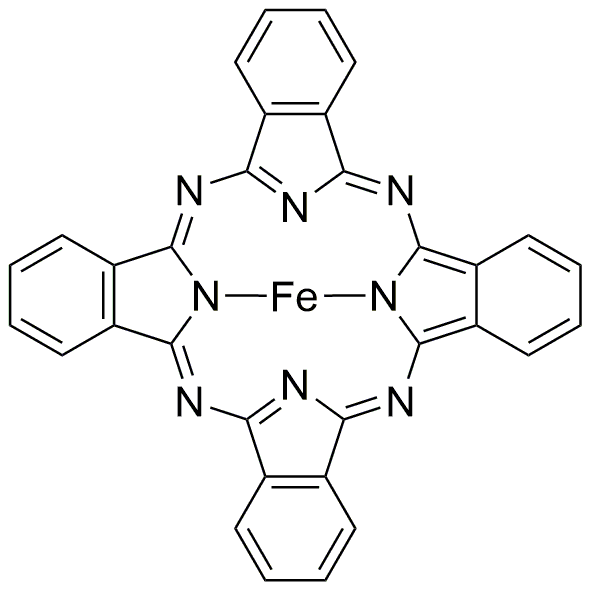Iron(II) phthalocyanine is widely utilized in research focused on:
- Catalysis: This compound serves as a catalyst in various chemical reactions, particularly in the oxidation of organic substrates. Its stability and efficiency make it a preferred choice in industrial processes, enhancing reaction rates and yields.
- Electrochemical Applications: Iron(II) phthalocyanine is used in the development of electrochemical sensors and batteries. Its ability to facilitate electron transfer makes it ideal for improving the performance of energy storage devices.
- Environmental Remediation: The compound is effective in degrading pollutants, such as dyes and heavy metals, in wastewater treatment. Its application in this field helps industries meet regulatory standards while promoting sustainability.
- Photovoltaic Devices: In the field of solar energy, Iron(II) phthalocyanine is employed in organic photovoltaic cells. Its light-absorbing properties contribute to the efficiency of converting sunlight into electricity.
- Biomedical Research: This chemical is being explored for its potential in drug delivery systems and as a contrast agent in imaging techniques. Its biocompatibility and functional versatility make it a promising candidate for advancing medical technologies.
General Information
Properties
Safety and Regulations
Applications
Iron(II) phthalocyanine is widely utilized in research focused on:
- Catalysis: This compound serves as a catalyst in various chemical reactions, particularly in the oxidation of organic substrates. Its stability and efficiency make it a preferred choice in industrial processes, enhancing reaction rates and yields.
- Electrochemical Applications: Iron(II) phthalocyanine is used in the development of electrochemical sensors and batteries. Its ability to facilitate electron transfer makes it ideal for improving the performance of energy storage devices.
- Environmental Remediation: The compound is effective in degrading pollutants, such as dyes and heavy metals, in wastewater treatment. Its application in this field helps industries meet regulatory standards while promoting sustainability.
- Photovoltaic Devices: In the field of solar energy, Iron(II) phthalocyanine is employed in organic photovoltaic cells. Its light-absorbing properties contribute to the efficiency of converting sunlight into electricity.
- Biomedical Research: This chemical is being explored for its potential in drug delivery systems and as a contrast agent in imaging techniques. Its biocompatibility and functional versatility make it a promising candidate for advancing medical technologies.
Documents
Safety Data Sheets (SDS)
The SDS provides comprehensive safety information on handling, storage, and disposal of the product.
Product Specification (PS)
The PS provides a comprehensive breakdown of the product’s properties, including chemical composition, physical state, purity, and storage requirements. It also details acceptable quality ranges and the product's intended applications.
Certificates of Analysis (COA)
Search for Certificates of Analysis (COA) by entering the products Lot Number. Lot and Batch Numbers can be found on a product’s label following the words ‘Lot’ or ‘Batch’.
Numéro de catalogue
Numéro de lot/série
Certificates Of Origin (COO)
This COO confirms the country where the product was manufactured, and also details the materials and components used in it and whether it is derived from natural, synthetic, or other specific sources. This certificate may be required for customs, trade, and regulatory compliance.
Numéro de catalogue
Numéro de lot/série
Safety Data Sheets (SDS)
The SDS provides comprehensive safety information on handling, storage, and disposal of the product.
DownloadProduct Specification (PS)
The PS provides a comprehensive breakdown of the product’s properties, including chemical composition, physical state, purity, and storage requirements. It also details acceptable quality ranges and the product's intended applications.
DownloadCertificates of Analysis (COA)
Search for Certificates of Analysis (COA) by entering the products Lot Number. Lot and Batch Numbers can be found on a product’s label following the words ‘Lot’ or ‘Batch’.
Numéro de catalogue
Numéro de lot/série
Certificates Of Origin (COO)
This COO confirms the country where the product was manufactured, and also details the materials and components used in it and whether it is derived from natural, synthetic, or other specific sources. This certificate may be required for customs, trade, and regulatory compliance.


